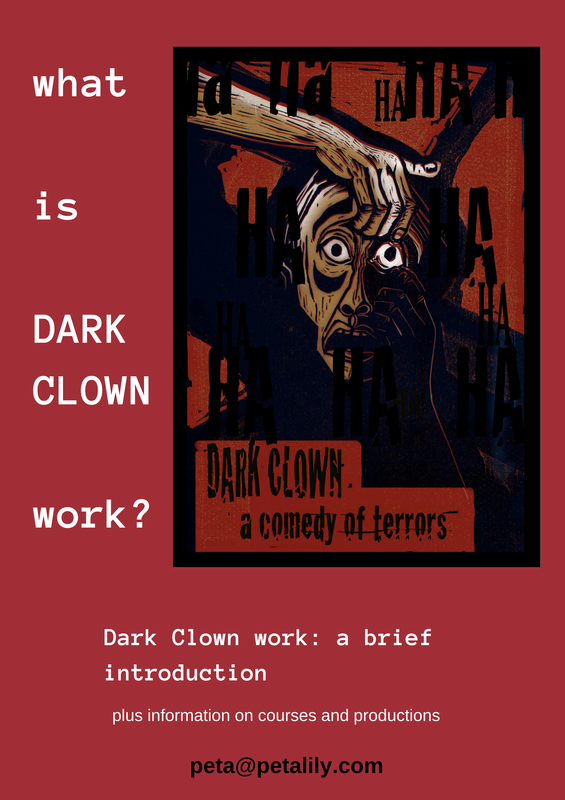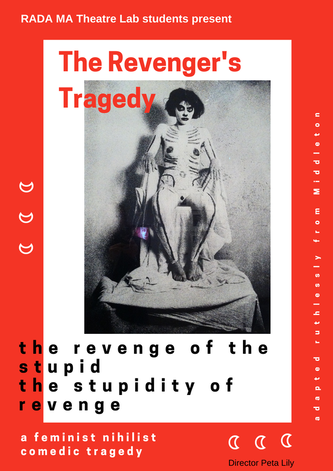 'With a Throne' - image by Hungarian artist Zsuzsanna Ujj, borrowed for this unofficial poster - in-school performances only. and is the inspiration for the character of Gloriana, created for MA Theatre Lab productions of The Revengers Tragedy
'With a Throne' - image by Hungarian artist Zsuzsanna Ujj, borrowed for this unofficial poster - in-school performances only. and is the inspiration for the character of Gloriana, created for MA Theatre Lab productions of The Revengers Tragedy As part of my Drama School teaching, it is my great joy to be tasked with creating clown pieces.
Just before the quarantine started, I was working on a student production: Clowns perform John Ford's 'Tis Pity She's a Whore. It's a theatre laboratory course so our brief includes deconstructing and responding to the original text.
The group were all on board with including a feminist point of view. They had recently created a scene to deal with the role of women in their previous module's production of Threepenny Opera.
John Ford actually writes well for women - the female characters here are spirited, feisty and wry, even so, the idea of the clowns coming out saying 'We have a problem with the title!' was in the forefront of my mind.
I developed a process for approaching classical texts to be played by clowns.
In previous years, we worked with The Revengers Tragedy. One year we used a #DarkClown concept: the audience entered to find themselves in a 'rehabilitation centre for clowns'. The concept was: sweet clowns are punished by being forced to present a vicious and violent play, so that they can better fit into society. Towards the end of the show, there was an alarm and an announcement - the clowns had failed at their task and had to depart as their identifying number was called. I had given this direction: 'You are leaving to your death. The prop you are holding now will be the instrument of your death.'
One character left with a haunted face, holding a cucumber before him ...
Another year, a different production/concept for TRT, an organisation of clowns were attempting to understand the 'sad normals' (regular people). The production was divided into chapters: The Clowns try to understand Power. The Clowns try to understand Flawed Humanity. The Clowns try to understand Grief. The Clowns try to understand The Plot ... etc.
I am always inspired by the underdog and for me clowning is a way to present neglected points of view. With The Revengers Tragedy, we included Vindice's dead girlfriend Gloriana as a speaking role. After the scene where Vindice dresses the corpse of his dead beloved (Gloriana), in order to trick and wreak a pointed revenge on the Duke, poor Gloriana, decked in a necklace of 'Magic Tree' car deodorisers (the text said 'raise the perfumes', we made a nod at the room for the sin of Sloth in the film SEVEN) broken-heartedly mourns to Vindice: 'You used me!' This was all the more poignant for by being played with wonderful sensitivity and vulnerability by a very tall male student.
Clown Dramaturgical Process
An early step is to check out what skills your group has - appoint a monitor and circulate a list. A skill can help inspire a scene. The act of making the list puts that elements in the group imagination. It's also a concrete invitation into clown thinking e.g. 'when can we fit acrobatics into this classical text?' One student was thirsty to use her mime skills which led to the idea of a play-within-the-play scene between relatively minor characters Philotis and Bergetto being played by a single performer in a half-and -half costume - check out RuPaul's Drag Race Season 7 Ep 10.
A key step in the devising adaptation is the Clown Council. We make a circle of chairs. Everyone takes a seat and enters clown state. I tell them that this is a meeting of the Clown Council and they are instructed to stand up when they feel the urge to speak about the themes of the play. I act as scribe to capture what the clowns say.
Later, back in 'sad normal' state, we discuss and find common ground / significant connections.
I encouraged students to put forward their favourite moments from the play, nurturing the emotional connection of clown through their enthusiasms for and reactions to the text.
Processes I used in earlier years included using Arnold MIndell's World Cafe process and the Marketplace Lazy Susan (more information on that process to come perhaps in another post).
Looking to the underrepresented led to the idea for extra scenes for Putana and Hippolita, and the acknowledgement of the point of view of the embryo produced from the love affair between Annabella and Giovanni. It is good to bear in mind that a clowns don't discriminate between the animate and inanimate the way 'sad normals' do. Annabella's heart is brought onstage in Act Five, skewered on Giovanni's knife. In our production, one clown eagerly volunteered to play the heart.
Taking things literally is another useful vein. A quick instance from one of the The Revenger's Tragedy productions - one clown played Vengeance and came on every time Vengeance was mentioned (once mistakenly coming on at the mention of Virtue) and when Vindice raised his sword and said: 'now nine years' vengeance crowd into a minute!' (3.5.124), Vengeance came on and stopped the show as he counted 'one Mississippi, two Mississippi, three Mississippi ...' Yup, all the way to 'sixty!'
Another process consists is the theme ideas cloud: I pair students up randomly and assigning each pair a theme. I ask them to put their clown brains and hearts to this task - to think of metaphors and clown-logic ideas, and songs for possible inclusion.
Making Metaphors concrete: working on this year's text: 'Tis Pity She's a Whore, one student, working on the theme of Vows came up with the idea of a ring. Vows are binding. Two Clowns conjoin themselves by wearing a rubber ring in various unwieldy ways, hampering their joy and freedom. Another pair of clowns had the idea of costuming themselves as halves of a pantomime horse. The clown playing Annabella would have worn a horse's bridle, making visual Annabella's status as property which is being negotiated for. Intuition can bring extra comic grace notes. One clown was fascinated by the mention of Parmesan cheese in the text (which is set in Parma) - this would have been inserted as a choric running motif. Another clown was perplexed by the mention of melons in the play - the event where Putana's eyes are put out could have included a clown sitting quietly onstage using a kitchen utensil to make melon balls, while the clown playing Putana screamed.
Costume as dramaturgy. If there is an overriding concept - e.g. Clown Correctional Centre cited earlier - there will be a base costume (or base colour palette) serving that reality and indicating the prison costume or the prison atmosphere. Elaborate bits such as period ruffs would be permitted/supplied by the authorities and clown props (balloon, wooden saw) could work their way in to make a poignant contrast. For 'Tis Pity, I held conversations with each student regarding what their clown might be wearing. A Jacobean crinoline would be worn by one clown, mime apparel for another and two clowns chose cowboy gear. One clown was inspired to wear a rabbit headdress and costume (think Donnie Darko) - this came intuitively from their imagination being captured by Vasques' line 'let my hot hare have law.' This 'Punishment Rabbit' could have appeared intermittently, providing a wonderful irrational way to underscore the theme of hot-headed violence which erupts more than once in the play. There can be sense in nonsense.
The combined metaphors, prop, improvs and running gag ideas birthed a coherent (according to clown logic) approach and the whole would have come together something like this:
'Tis Pity She's a Horse
The clowns found a script in the back of a Ford Fiesta.
They were really impressed that,
while singlehanded-ly revolutionising the automotive industry (yay horsepower),
Ford (clowns get things wrong)
had somehow also found the time to also write a play
(and make some fine Western movies, too, apparently).
The clowns felt that their presentation of ''Tis Pity She's a Horse' (sic) would be a great opportunity to show that clowns can do high-brow material.
Well some of them. A couple of them just welcomed an opportunity to dress as cowboys.
Or as Death (from The Seventh Seal).
Under the 'leadership' of a Peter Quince-like Company Manager,
this famous tale of incestuous love would have begun
with a smooth, lively rendering of Sly and the Family Stone's 'It's a Family Affair', with a circular parade of pairs giving quick snapshots of innocent sibling jostling and, on a second circuit, snap-shots of physical less-innocent curiosity.
The various suitors would have competed in a Derby for the hand of Annabella.
Soranzo would have disqualified Grimaldi for unspecified reasons and
Bergetto's horse would have been shot, and sadly not responded to any of the normal methods of resuscitation.
Hippolita would have made a splendid entrance with
terrifying black-bin-bag wings and spoken of her betrayal with Valkyrie-like rage.
There would have been interruptive appearances by the 'Punishment Rabbit' (see above),
and a Public Service Announcement
about how the stork arrives when he sees True Love.
There would have been a special appearance by the promptly conceived
Clown of Shame, with an Oedipus-inspired monologue:
Whose tale more shameful than mine,
whose lot more dire?
My motheraunt and uncledad
Did beget me, commingled in one bed.
The fruit of sibling loins;
Monstrous progeny made in equal parts
of sublimest love and darkest sin.
Ah me! ah woe! oh misery!
And my life short and brutish in the dark
To be murdered unclean and unborn
by my uncledad’s blade ...
Was ever nephewson afflicted thus!
(lines mashed from Oedipus, Hamlet and TRT)
Annbella, Putana and Hippolita would have risen up from their various deaths to
address their dead beloveds (using text from Oscar Wilde’s Salome):
Ah! thou wouldst not suffer me to kiss thy mouth. Well! I will kiss it now. I will bite it with my teeth as one bites a ripe fruit ... There was a bitter taste on thy lips.
It would have been edgy, elevated and stupid - with touches of pathos and just a little feminist rage.
Due to COVID-19, the production only exists now in the imagination.
But the imagination is a wonderful place.
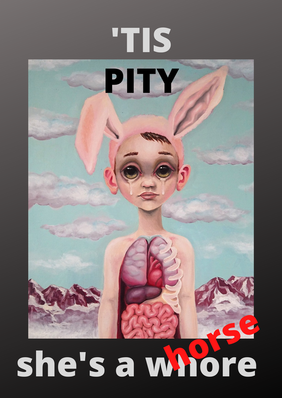
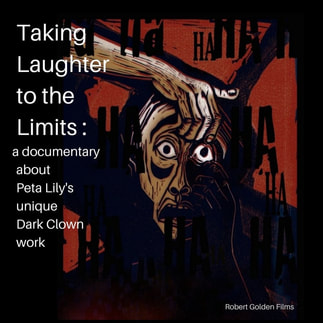
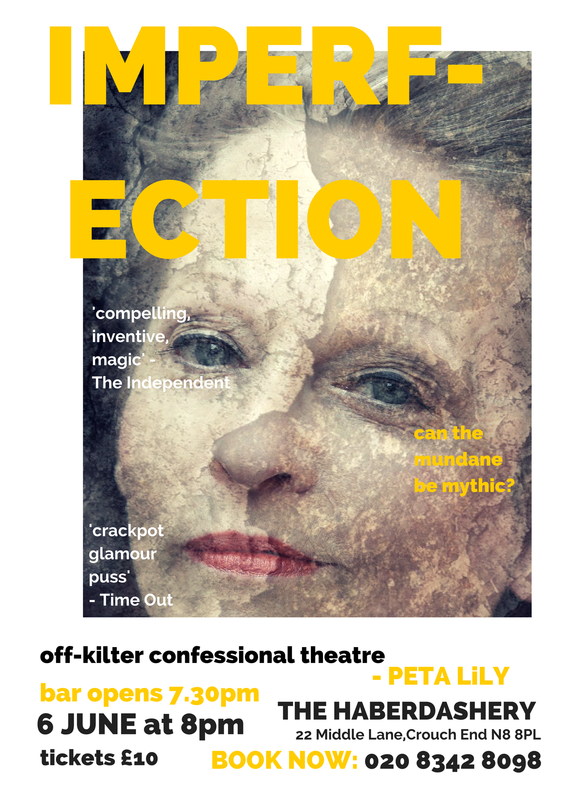
 RSS Feed
RSS Feed
